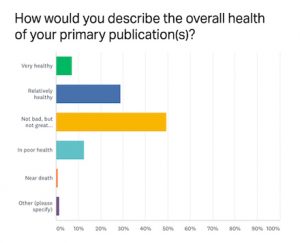Each year, I survey U.S. publishers and general managers about the health of their newspapers. During the late spring/early summer of 2020, I received completed surveys from participants representing 500 newspapers or groups. In my previous column, I discussed some of the overall results of the survey, especially those related to financial health. In this column, we’re going to look at some of the differences noted between daily and weekly newspapers.

In some areas of the survey, there were little differences between weeklies and dailies. For instance, when compared to two years ago, both groups report similar health. While 58 percent of weekly newspapers indicate worse overall health than two years ago, 63 percent of dailies gave the same response. Most newspapers in both groups answered “not bad” to “very healthy” when asked about their overall health, while 14 percent of weeklies and 19 percent of dailies indicated they were in poor health.

When it comes to page count, again we see some similarities. 68 percent of dailies answered they had reduced pages compared to two years ago, while 61 percent of weeklies responded similarly.
Digging into other questions, we begin to see differences between dailies and weeklies:
- 71 percent of weekly newspapers are independent, with local owners, while only 27 percent of daily newspapers are owned and operated in their local communities.
- The primary source of revenue for 98 percent of weekly newspapers is print advertising. The same is true for 81 percent of dailies, with subscriptions and digital advertising bringing in a higher percent of revenue than at weeklies.
- While only 7 percent of weekly newspapers answered that their digital efforts were financially profitable, 22 percent of daily papers see a financial profit on digital platforms. 30 percent of weeklies and 43 percent of dailies indicate they see other benefits besides financial profit from their digital efforts.
- 30 percent of daily newspapers report that more than 20 percent of their revenues come from “non-newspaper sources.” Only 6 percent of weeklies responded the same way.
Speaking of digital, only 32 percent of daily newspaper publishers/managers responded that it “might be true” that they would be better off without a digital version of their newspaper. That number jumps up to 44 percent for weekly papers, with an additional 15 percent indicating they believed they “would be better off” without a digital version. Add those together and 59 percent of weekly respondents answered they might, or would, be better off without a digital version of their newspaper.
One answer that has changed significantly since I began surveying newspapers six years ago is “How long do you think you will continue to produce a printed newspaper?” In 2015 and 2016 surveys, more than 90 percent indicated they would be producing newspapers more than 20 years into the future. In this most recent survey, roughly 48 percent of weeklies and 39 percent of dailies expect to be printing papers more than 12 years from now.
What about all that “fake news” we keep hearing about? Fortunately, fake news is “fake news” in most places. While it is a problem for many daily newspapers where 21 percent of respondents answered that more than 25 percent of the folks in their communities consider them to be fake news, weekly newspaper seem to be more trusted by their communities. Only 2 percent of weekly newspapers answered, “more than 25 percent,” while 39 percent of weeklies responded, “That’s silly. None. Zero.” 51 percent of weeklies answered, “Somewhere between 1 and 10 percent.”
I guess it just goes to show, there are always a few crabby readers out there.
In the 2020 survey, hundreds of respondents sent in advice and suggestions about things that have worked at their newspapers. In my next column, we’ll take a look at ideas newspapers have come up with to increase revenue and readership. Yes, 12 percent of weeklies and 17 percent of dailies report being in better overall health than two years ago. We’re going to find out why.
